
The Universal Product Code (UPC) and the European Article Number (EAN) are two primary barcoding systems used globally for product identification. Originating from the US and Europe, respectively, they serve distinct markets but share core functionality – identifying a product’s unique attributes.
This article breaks down the histories, differences, and practical applications of UPC and EAN barcode formats, providing a clear guide for businesses navigating international trade.
The journey of barcodes as pivotal tools in product identification began with the introduction of the Universal Product Code. Developed by IBM in 1971, the UPC barcode was envisioned as a universal product identification symbol, primarily catering to the needs of the United States and Canada. Its 12-digit structure was designed to streamline the retail checkout process, marking a significant advancement in point-of-sale technology.
Meanwhile, across the Atlantic, Europe recognised the potential of such a system but identified a need for an additional digit to represent different countries. This led to the birth of the European Article Number (also called the International Article Number). Introduced by the International Article Numbering Association, the EAN barcode added a country-specific digit at the front, resulting in a 13-digit code. This adaptation allowed for a more global application, making it suitable for diverse countries and products.
Over time, while the UPC became the standard in North America, the EAN found widespread acceptance in other parts of the world. The coexistence of these two systems laid the foundation for the modern barcoding standards we see today, each tailored to the unique needs of their respective regions yet interconnected in the global marketplace.
Please visit our barcode learning centre to learn more about the barcoding technology used today.
Let’s quickly learn about the two barcode symbology types.
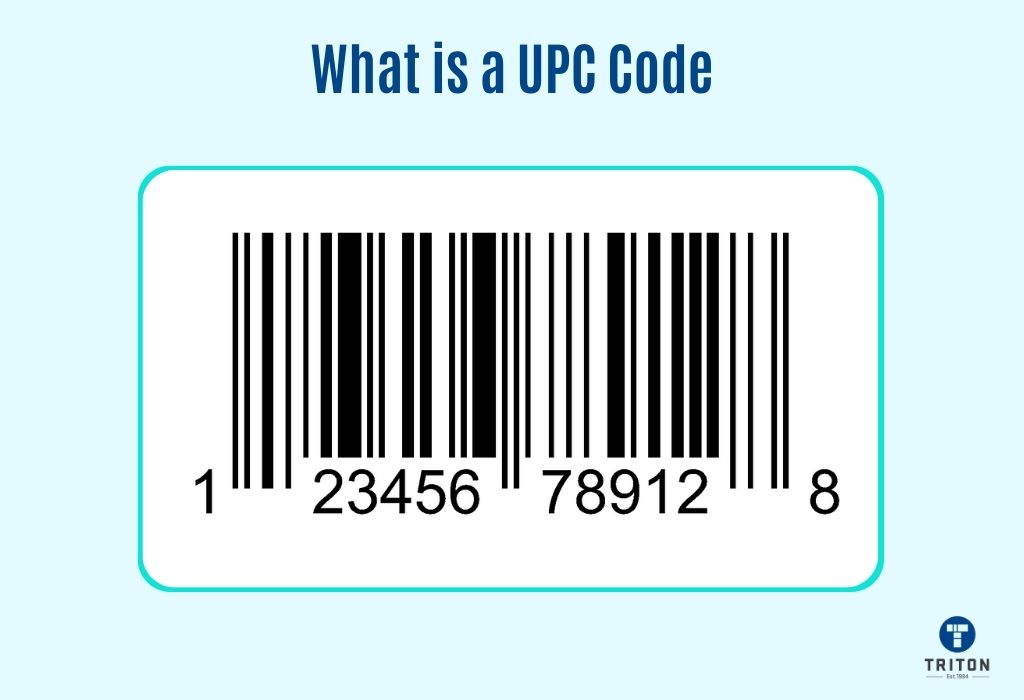
Universal Product Code, often abbreviated as UPC, is a 12-digit barcode. It’s a unique identifier that helps retailers scan the price at checkout and manage their inventory efficiently. Introduced in the 1970s, the UPC was designed to uniquely identify products at the point of sale, making the checkout process more efficient.


There are two types of UPC barcodes – UPC-A and UPC-E.
UPC-A: This is the standard 12-digit Universal Product Code commonly used in the United States and Canada. It contains a unique numerical identifier for products and is widely used in retail settings for scanning and inventory management.
UPC-E: This is a condensed version of UPC-A, containing only 6 digits. It’s used for smaller packaging where a full UPC-A barcode wouldn’t fit. It can be expanded back to its UPC-A equivalent for scanning.
Check out our dedicated what is UPC code guide to learn the ins and outs of UPC barcoding technology.
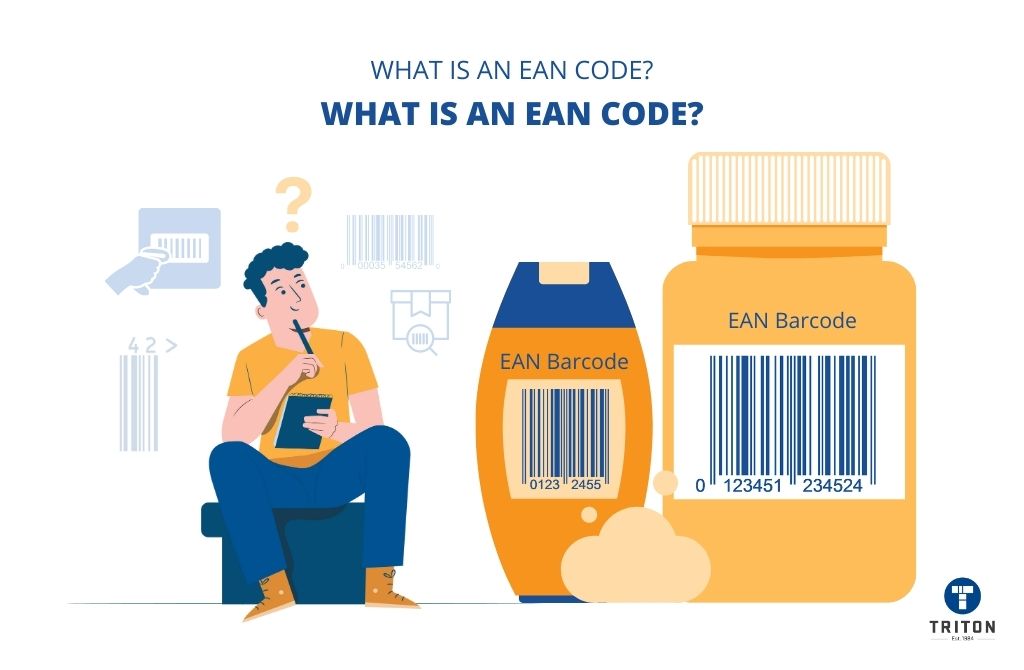
European Article Number, often abbreviated as EAN, is a 13-digit barcode used mainly in Europe and other countries around the world. Like the UPC, it serves as a unique identifier for products, aiding in price scanning at checkout and inventory management.
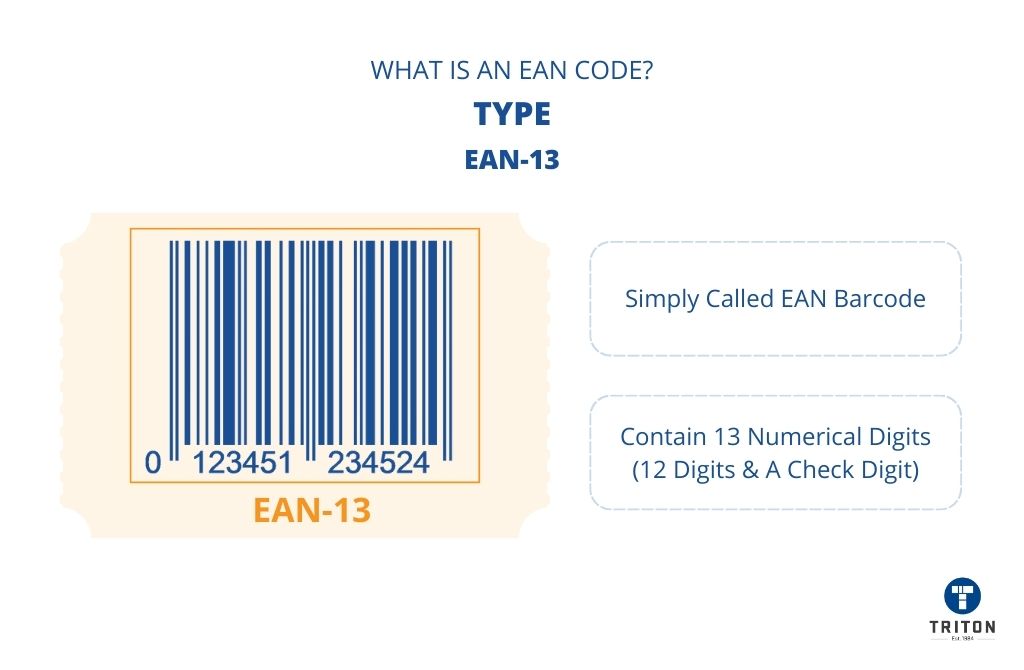
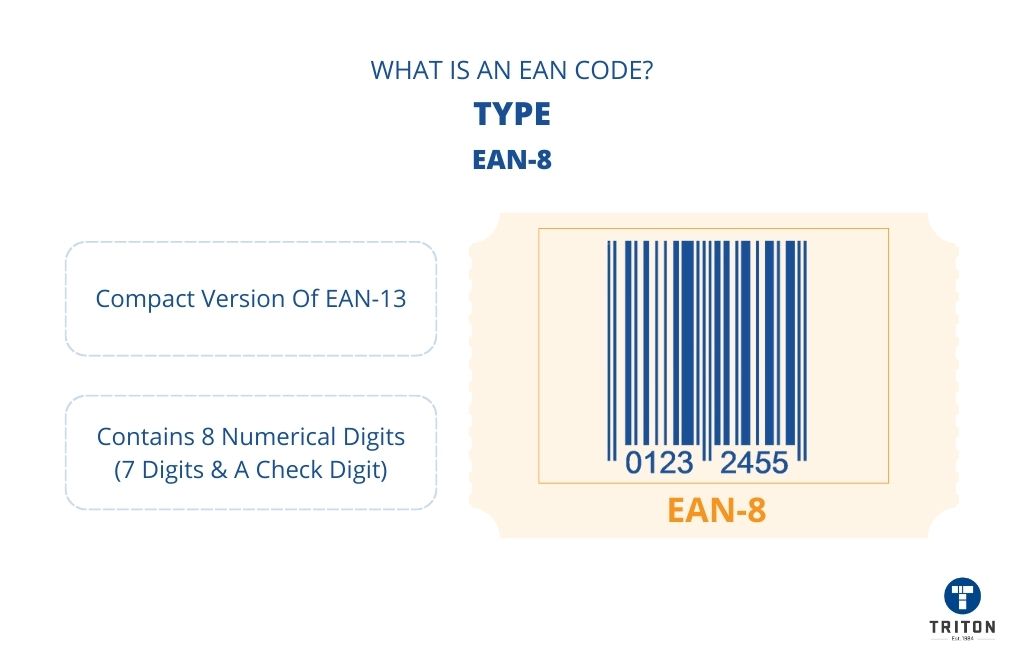
EAN-13: This is the standard European Article Number with 13 digits. It’s used globally and is compatible with most international scanning systems. The extra digit allows for more country codes, making it versatile for international trade.
EAN-8: This is a shortened version of the EAN-13 barcode, containing only 8 digits. It’s used for smaller products and packaging where an EAN-13 barcode would be too large. Like UPC-E, it can be expanded to its EAN-13 equivalent.
Read our comprehensive guide on what is an EAN code to learn everything about EAN barcoding technology.
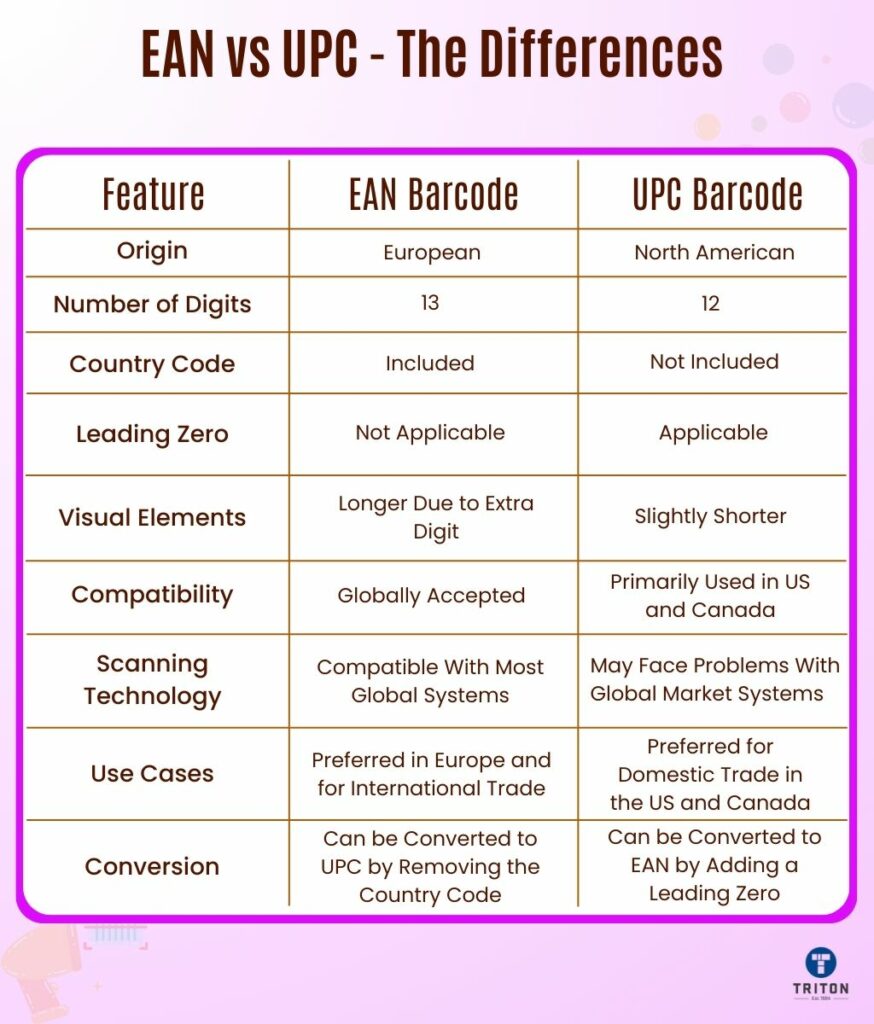
Here is a table that summarises the key differences between UPC code and EAN codes.
Feature | EAN | UPC |
|---|---|---|
Origin | European | North American
|
Number of Digits
| 13 | 12 |
Country Code
| Included | Not Included
|
Leading Zero
| Not Applicable
| Applicable, gives individuality to UPC
|
Visual Elements
| Longer due to extra digit
| Slightly shorter
|
Compatibility | Globally accepted
| Primarily used in the U.S. and Canada
|
Scanning Technology
| Compatible with most global scanning systems | May face problems when global market is considered |
Use Cases
| Preferred in Europe and for international trade
| Preferred for domestic trade within the U.S. and Canada
|
Conversion | Can be converted to UPC by dropping the country code | Can be converted to EAN by adding a leading zero
|
Let’s now take an in-depth look at the differences between UPC and EAN codes.
UPC codes consist of 12 digits and do not have a leading zero. The leading zero in a UPC barcode is the initial “0” that precedes the rest of the numbers. This zero is significant when converting between UPC and EAN formats. In contrast, EAN codes are 13 digits long and often start with a leading zero, especially when converted from a UPC code. This extra digit allows EAN codes to include country-specific information, making them more versatile for international commerce.
A country code in a barcode is a specific set of digits that indicate the country where the product is registered. EAN codes include a country code, allowing for more nuanced product identification and facilitating international trade.
On the other hand, UPC codes do not have a designated country code as part of their structure. However, the manufacturer identification number in UPC can sometimes serve as an alternative to indicate the origin, although it’s not as specific as the country code in EAN. This makes EAN more versatile for global operations.
Geographically, EAN and UPC barcodes have distinct areas of usage.
EAN codes are predominantly used in Europe and are globally accepted, making them ideal for international trade.
On the other hand, UPC codes are primarily used in the United States and Canada and are optimised for domestic retail environments.
These geographical preferences influence the choice of barcode for businesses based on their operational reach.
Choosing between UPC and EAN often depends on your target market.
If your business is focused on the United States and Canada, UPC is the preferred choice due to its widespread acceptance in these regions.
EAN is more suitable for companies aiming to sell products internationally or in European markets because of its global compatibility.
Understanding your market reach is crucial in selecting the appropriate barcode system for efficient inventory management and seamless transactions.
EAN codes are visually longer due to the inclusion of an extra 13th digit. This makes them easily distinguishable from UPC codes, which have only 12 digits. The visual difference is particularly noticeable when the two types of barcodes are printed next to each other.
Read our guide on how to visually identify barcode types to learn the art of visually recognising barcode types.
Both EAN and UPC have compact versions known as EAN-8 and UPC-E. These shorter barcodes are used when there is limited space on a product’s packaging. Despite their reduced size, they still offer efficient product identification.
While both EAN and UPC use a numeric character set for encoding, the vertical line and spacing patterns can differ slightly due to the extra digit in EAN. This variation may affect how certain scanning systems interpret the barcodes, although most modern scanners can read both types.
EAN and UPC barcodes both feature a check digit at the end for error verification.
When a scanner reads the barcode, it performs a quick mathematical calculation using the other digits. If the result matches the check digit, the scan is considered accurate; otherwise, an error is flagged.
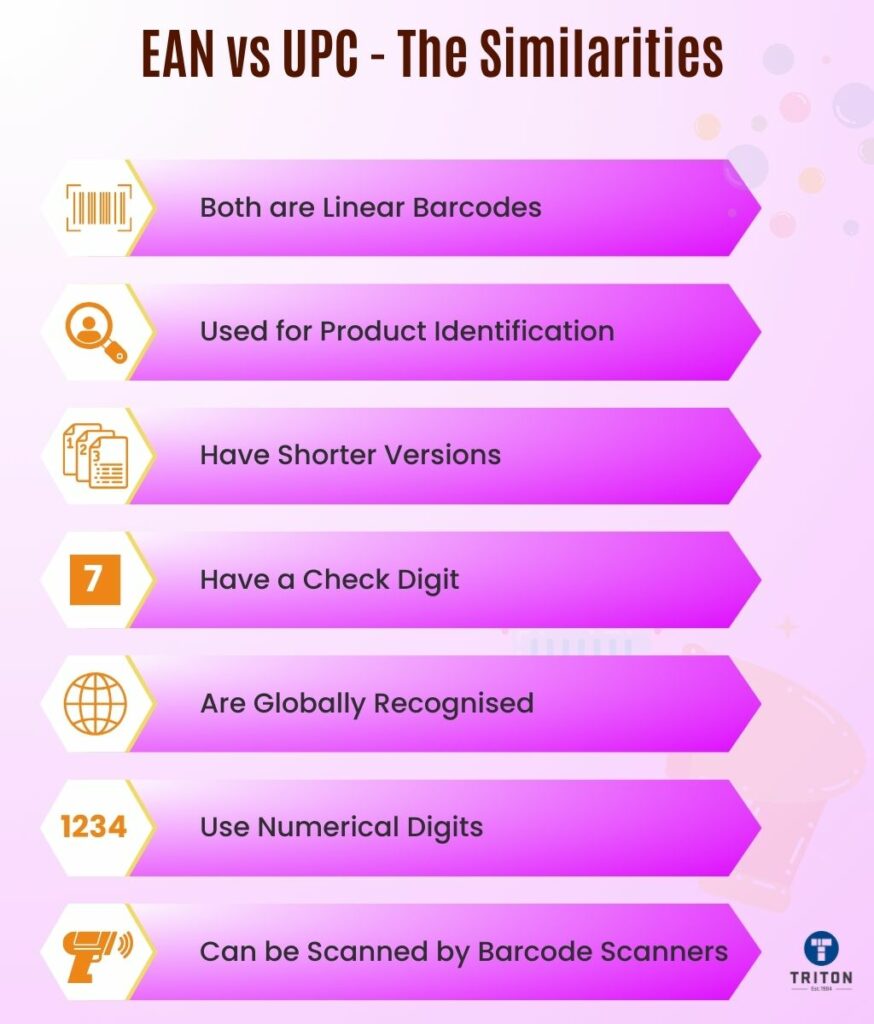
Despite their differences, EAN and UPC barcodes share several key similarities. These similarities are discussed below.
Both UPC and EAN are types of linear barcodes consisting of parallel lines with varying widths and gaps that signify distinct characters. They are composed of alternating black bars and white spaces. Both UPC and EAN codes also have human readable numbers below the pattern.
Refer to our barcode 101 guide to learn more about barcodes, their working and types.
UPC and EAN barcodes serve the primary function of identifying items in retail environments, marketplaces, and storage facilities. They contribute to effective inventory control and expedite the checkout procedure, benefiting both store owners and consumers.
Shorter versions of UPC and EAN exist, known as UPC-E and EAN-8, respectively. These compact codes employ zero suppression, a method that removes leading zeros, allowing the barcode to fit on smaller products without sacrificing identification efficiency.
A check digit is present at the end of both UPC and EAN barcodes for verification purposes. Scanners use this digit to perform a quick mathematical check against the other digits in the code. If the check digit matches the calculated result, the scan is deemed accurate; otherwise, an error is flagged.
GS1 (previously known as Uniform Code Council), the global standard-setting body for barcodes, governs both EAN and UPC systems, ensuring their international standardisation. This means that both types of barcodes adhere to a consistent structure and set of rules, making them universally recognisable and scannable.
The GS1 governance ensures that whether you’re using an EAN or UPC, the barcode will comply with international standards, facilitating seamless trade and inventory management across borders.
UPC and EAN barcodes use a numeric encoding system, representing numbers from 0 to 9. Each digit in these barcodes corresponds to a unique pattern of bars and spaces, which scanners interpret back into the original numbers.
EAN is essentially an extended form of UPC. Scanning systems capable of reading EAN-13 codes are generally also equipped to read UPC-A codes. This removes the necessity for multiple scanning devices, allowing for seamless scanning of both barcode types.
In any retail environment, the importance of quick and accurate scanning can’t be overstated. It’s not just about speeding up the checkout process; it’s about inventory management, customer experience, and, ultimately, your bottom line. That’s why at Triton, we’ve curated a selection of high-quality barcode scanners to meet a variety of needs.
We proudly feature products from industry leaders such as Honeywell and Zebra, ensuring you have access to the most reliable scanning solutions on the market. Our diverse inventory is tailored to meet a variety of needs, offering everything from general-purpose scanners and mobile terminals to specialised options like rugged scanners, 2D scanners, USB scanners, wireless scanners, and Bluetooth scanners, as well as fixed-mount scanners and sensors. We also offer a variety of barcode scanner accessories and additional cables to help you get the most out of your barcode scanners.
With Triton, you’re not just purchasing a product; you’re investing in a solution that elevates your operational efficiency.
As technology evolves, both EAN and UPC barcodes are likely to see enhancements in readability and data storage. With the rise of smart technology, we may witness the integration of these barcodes with IoT devices for real-time tracking and analytics.
Additionally, there’s a growing trend towards adopting other barcode symbologies like QR codes, Data Matrix codes and Aztec codes, which can store more data and link directly to digital platforms. However, EAN and UPC are expected to remain industry standards for the foreseeable future due to their widespread adoption and ease of use.
Yes, EAN codes have a country code. This makes them more versatile for international trade.
Yes, you can convert EAN to UPC by removing the leading zero and vice versa.
Yes, modern barcode scanners are equipped with scan engines to read both UPC and EAN barcodes.
EAN codes have 13 digits and are slightly longer than UPC codes, which have 12 digits. The length difference is often noticeable.
Yes, BarTender Software is able to generate both of these codes and variations. Check out the article answering top BarTender Software questions addressing this and more.
In conclusion, both EAN and UPC barcodes play a crucial role in product identification and inventory management. While EAN is more versatile for global operations due to its country code, UPC is a go-to choice for businesses in the United States and Canada.
Understanding their differences and similarities can guide you in selecting the most suitable bar code system for your business needs.
We hope this article was useful.
Thanks for reading!
Melbourne
Brisbane
Phone 1300 558 438
Live Chat – Widget below
Melbourne
Brisbane
Phone 1300 558 438
Live Chat – Widget below